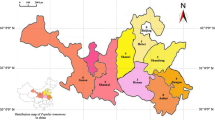Abstract
The genotyping of 75 trees from poplar plantations in St. Petersburg and Leningrad oblast was conducted with microsatellite markers to identify the elite clonal varieties developed by P.L. Bogdanov in the period of 1938–1965. The information about the varieties was lost. The authentic herbarium specimens of poplar clonal varieties preserved at the St. Petersburg State Forest Technical University were used as reference genotypes. According to the results of DNA fingerprinting, we identified the clonal plantations of Populus × newesis Bogd. and Populus × leningradensis Bogd. from the Kartashevskii forest district and the arboretum of the St. Petersburg State Forest Technical University. The identified elite poplar hybrids have a higher frost resistant and a higher growth rate. They are recommended for plantation cultivation in the northwest of Russia.
Similar content being viewed by others
References
Stanton, B., Liu, B., and Silva, C.S., Hybrid poplar and the pulp and paper industry in North America: implications for a secured supply of quality fiber for papermakers worldwide. http://greenwoodresources.com/wp-content/uploads/2014/09/hybrid-poplar-white-paper.pdf. Accessed December 22, 2015.
Poplar Silviculture: Plantations and Native Stands (Proceedings of the Annual Meeting of the Poplar Council of Canada, 2003), Quebec: Rouyn-Noronda, 2003.
Improving Lives with Poplars and Willows, Synthesis of Country Progress Reports, 24th Session of the International Poplar Commission. Working Paper IPC/12, Rome: FAO, 2012.
Tsarev, A.P., Sortovedenie topolya (Study of Poplar Breeds), Voronezh: Voronezh Gos. Univ., 1985.
Sivolapov, A.I., Chernodubov, A.I., and Sivolapov, V.A., Poplar test crops in felling areas of Research Forestry, Voronezh State Forestry Engineering University named after G.F. Morozov, Lesnoi Zh., 2013, no. 1, pp. 33–37.
Sivolapov, A.I., Topol’ sereyushchii: genetika, selektsiya, razmnozhenie (Gray Poplar: Genetics, Selection, Reproduction), Voronezh: Voronezh Gos. Univ., 2005.
Sivolapov, A.I., Sivolapov, V.A., and Mashkina, O.S., The test results for new varieties of poplar, in Dostizheniya i problemy v lesnoi genetike i selektsii. K 40-letiyu NIILGiS: sbornik nauchnykh trudov (Advances and Challenges in Forest Genetics and Breeding. Towards the 40th Anniversary of Research Institute of Forest Genetics and Breeding: Collection of Scientific Papers), Voronezh: Nauchno-Issledovatel’skiy Institut Lesnoy Genetiki i Selektsii, 2010, pp. 199–210.
Sivolapov, A.I., Politov, D.V., Mashkina, O.S., et al., Cytological, molecular-genetic and silvicultural-selection research on polyploid poplars, Sib. Lesnoi Zh. 2014, no. 4, pp. 50–58.
Bogdanov, P.L., Topolya i ikh kul’tura (Poplars and Their Culture), Moscow: Lesnaya Promyshlennost’, 1965, 2nd ed.
Demidova, N.A. and Durkina, T.M., Growth and development of poplars in the European north of Russia, Lesnoi Zh., 2013, no. 5, pp. 78–87.
IUPOV, Guidelines for the Conduct of Tests for Distinctness, Homogeneity and Stability—Populus L., Geneva: International Union for the Protection of New Varieties of Plants, 1981.
Rathmacher, G., Niggemann, M., Wypukol, H., Gebhardt, K., Birgit, Z., and Bialozyt, R., Allelic ladders and reference genotypes for a rigorous standardization of poplar microsatellite data, Trees, 2009, vol. 23, pp. 573–583.
Dayanandan, S., Rajora, O.P., and Bawa, K.S., Isolation and characterization of microsatellites in trembling aspen (Populus tremuloides), Theor. Appl. Genet., 1998, vol. 96, pp. 950–956.
Rahman, M.H. and Rajora, O.P., Microsatellite DNA fingerprinting, differentiation, and genetic relationships of clones, cultivars, and varieties of six poplar species from three sections of the genus Populus, Genome, 2002, vol. 45, no. 6, pp. 1083–1094.
Liesebach, H., Schneck, V., and Ewald, E., Clonal fingerprinting in the genus Populus L. by nuclear microsatellite loci regarding differences between sections, species and hybrids, Tree Genet. Genomes, 2010, no. 6, pp. 259–269. doi 10.1007/s11295-009-0246-5
Bousquet, J., Simon, L., and Lalonde, M., DNA amplification from vegetative and sexual tissues of trees using polymerase chain reaction, Can. J. For. Res., 1990, vol. 20, pp. 254–257.
Khasa, D.P., Nadeem, S., Thomas, B., et al., Application of SSR markers for parentage analysis of Populus clones, For. Genet., 2003, vol. 10, no. 4, pp. 273–281.
Peakall, R. and Smouse, P.E., GenAlEx 6.5: genetic analysis in Excel. Population genetic software for teaching and research—an update, Bioinformatics, 2012, vol. 28, pp. 2537–2539.
DARwin: Dissimilarity Analisis and Representation for Windows. http://darwin.cirad.fr/darwin/index.html. Accessed December 22, 2015.
Bogdanov, P.L., Breeding of poplars, in Sbornik Trudov TsNIILH (Collection of Works of Central Scientific Research Institute of Forestry), Leningrad: Goslestekhizdat, 1940, pp. 3–64.
QIAxcel User Manual. https://www.qiagen.com/resources/download.aspx?id=c207a7c8-e4f3-41a6-9873-79c8b9196757&lang=en. Accessed December 22, 2015.
Thomas, H., Ageing in plants, Mech. Ageing Dev., 2002, vol. 123, pp. 747–753.
Taberlet, P. and Luikart, G., Non-invasive genetic sampling and individual identification, Biol. J. Linn. Soc., 1999, vol. 68, pp. 41–55.
Waits, L.P., Luikart, G., and Taberlet, P., Estimating the probability of identity among genotypes in natural populations: cautions and guidelines, Mol. Ecol., 2001, vol. 10, pp. 249–256.
FAO, Poplars and willows in wood production and land use, FAO For. Ser., 10, 1979.
Markova, I.A., et al., Lesosyr’evye plantatsii sosny i eli, (Pine and Spruce Timber Resource Plantations), St. Petersburg: Sankt-Peterburgskii Nauchno-Issledovatel’skii Institut Lesnogo Khozyaystva 2008, issue 1(7).
Murashige, T. and Skoog, F., A revised medium for rapid growth and bioassays with tobacco tissue cultures, Physiol. Plant., 1962, vol. 15, no. 3, pp. 473–497.
Zhigunov, A., Saksa, T., and Sved, J., Fundamentals of Container Tree Seedling Production, St. Petersburg: St. Petersburg Forestry Research Institute, 2011.
Author information
Authors and Affiliations
Corresponding author
Additional information
Original Russian Text © M.V. Lebedeva, E.A. Levkoev, V.A. Volkov, A.A. Fetisova, S.V. Navalikhin, D.A. Shabunin, Yu.I. Danilov, A.V. Zhigunov, E.K. Potokina, 2016, published in Genetika, 2016, Vol. 52, No. 10, pp. 1159–1168.
Rights and permissions
About this article
Cite this article
Lebedeva, M.V., Levkoev, E.A., Volkov, V.A. et al. The recovering of breeding achievements of Populus × leningradensis bogd. and Populus × newensis bogd. Based on microsatellite analysis. Russ J Genet 52, 1046–1055 (2016). https://doi.org/10.1134/S1022795416100069
Received:
Published:
Issue Date:
DOI: https://doi.org/10.1134/S1022795416100069




